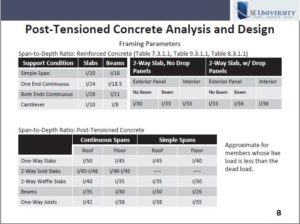Using post-tensioned concrete may seem like a daunting task for engineers who are more comfortable with traditional reinforced concrete design. However, post-tensioned concrete certainly allows for designs that cannot be achieved with traditional mild steel reinforced concrete, and improvements in construction methods have eliminated previous problems with corrosion of the steel strands. PT concrete can allow for thinner and longer spans, a reduction in shrinkage cracking, and allow for slabs on expansive soils. Its application is quite limitless, and as more designers become better educated in the PT design process, it will only increase in popularity.
In the October 2017 SE University session, Otto Schwarz, PE, SE, with Ryan Biggs | Clark Davis gave a talk on Post-Tensioned Concrete Analysis and Design. Otto gave an overview and presented examples of how to determine the prestress force using the feasible stress design method as well as load balancing. For the novice post-tensioned concrete designer, these examples covered the entire PT design process, including how to calculate prestress loss and its effect on ultimate strength design.
Otto also provided a comparison of span-to-depth ratios for reinforced concrete design versus post-tensioned concrete designs. As shown in the slide below, significant savings can be achieved in the depth of the concrete system when using post-tensioned concrete, and these span-to-depth ratios give a great starting point for framing parameters for engineers who are just getting their feet wet in PT design. Click on the slide to print your own copy.
If you’d like to consider Post-tensioned concrete as an alternative to reinforced concrete in your design, and would like additional resources, please see our blog post Tips for Designing with Post-tensioned Concrete.

